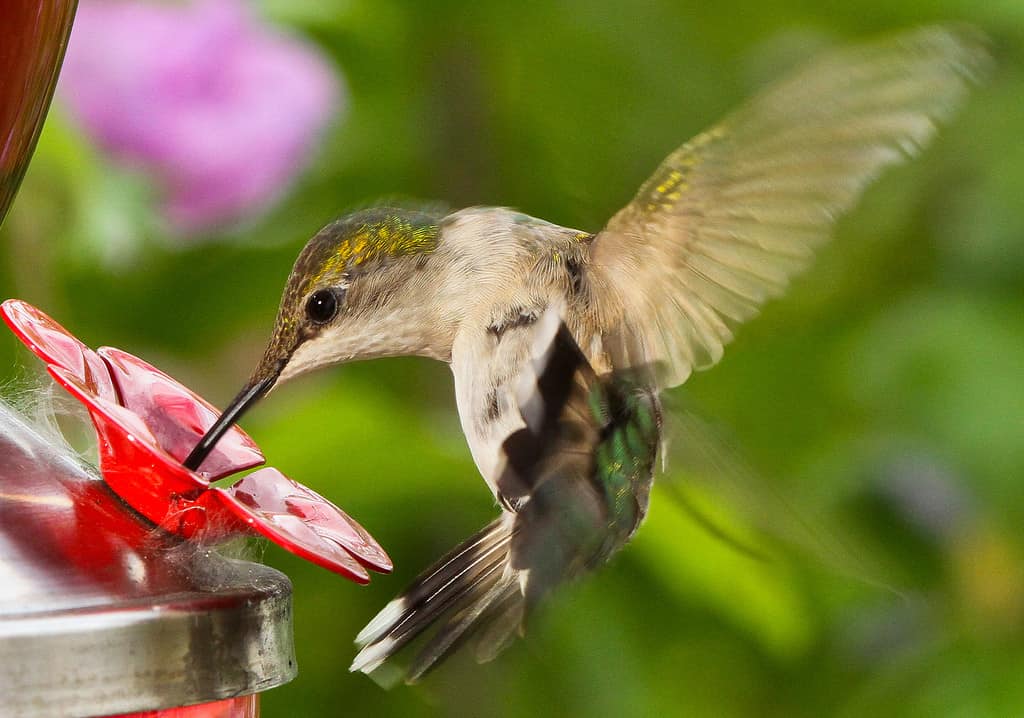Hummingbirds are a common sight in the gardens of South Carolina, with the ruby-throated hummingbird (Archilochus colubrisis) being the predominant species. The males have a distinctive ruby-red throat, a white collar, an emerald green back, and a forked tail. The females have a green back and tail and are banded with black and white. These little birds are only around three inches long. According to the Carolina Bird Club, there are also another six species resident in the state. These include the Rufous hummingbird and the black-chinned hummingbird but they are not spotted so often. So, let’s look at when hummingbirds return to South Carolina so that you can get your bird feeders and binoculars prepared!
When Do Hummingbirds Return To South Carolina?
According to the South Carolina Department of Natural Resources, male hummingbirds return to South Carolina in late March. You can spot their distinctive red throat bib. Then, around a week later, the females arrive. To begin with, you will only see them in small numbers. It will be midsummer before you will see them in significant numbers around your bird feeders.
What’s more, some hummingbirds use South Carolina as a stop off on their way further north. You may see an increase in activity around your feeders as they do this and then they disappear. Even the hummingbirds that are staying in your state may not be seen very often after the initial rush because they are busy raising their young. Others are simply choosing natural food sources over the ones that we provide!
Where Did The Hummingbirds Go?
Most spend their winter in Mexico or even further south into the tropics of South America. They travel over 4,000 miles in a year, beating their wings 58 times a second! The birds usually leave in the early fall – around September or October but some have left in late July. They mainly use day length as their cue to leave (which causes hormonal changes) and not the availability of food. The males leave first, followed by the females, and then the juveniles who need to build up their energy reserves for the journey.
Did All The Hummingbirds Leave?
Not all hummingbirds leave South Carolina in the fall as many people think. There are reports of mainly Rufous hummingbirds at water feeders in the state throughout the colder months. There have even been some winter sightings of the ruby-throated hummingbird but only near the coast.
Seeing Hummingbirds In South Carolina

Female ruby-throated hummingbirds do not have a ruby throat!
©Hooplion/iStock via Getty Images
Hummingbirds are charming and frequent visitors to South Carolina gardens and there are plenty of things that you can do to encourage them. The advice from the S.C. Department of Natural Resources is to landscape your garden with flowers that attract hummingbirds. We know that they are attracted to tubular red flowers so plants such as red salvia, trumpet creepers, and native azaleas are perfect. However, they also love hollyhocks, petunias, and impatiens and feed on small insects.
Thousands of South Carolina residents also put up red hummingbird feeders. You fill them with a sugary solution (one cup of sugar per quart of water). It can take a while for them to find the feeders so be patient. Very soon you will have gorgeous little visitors to keep you amused. Don’t worry that by doing this you are delaying their departure in the fall. If you leave the feeders up into the fall, you may help out late migrants who need to stop off for a rest in South Carolina on their way back to their winter homes further south!
Thank you for reading! Have some feedback for us? Contact the AZ Animals editorial team.







